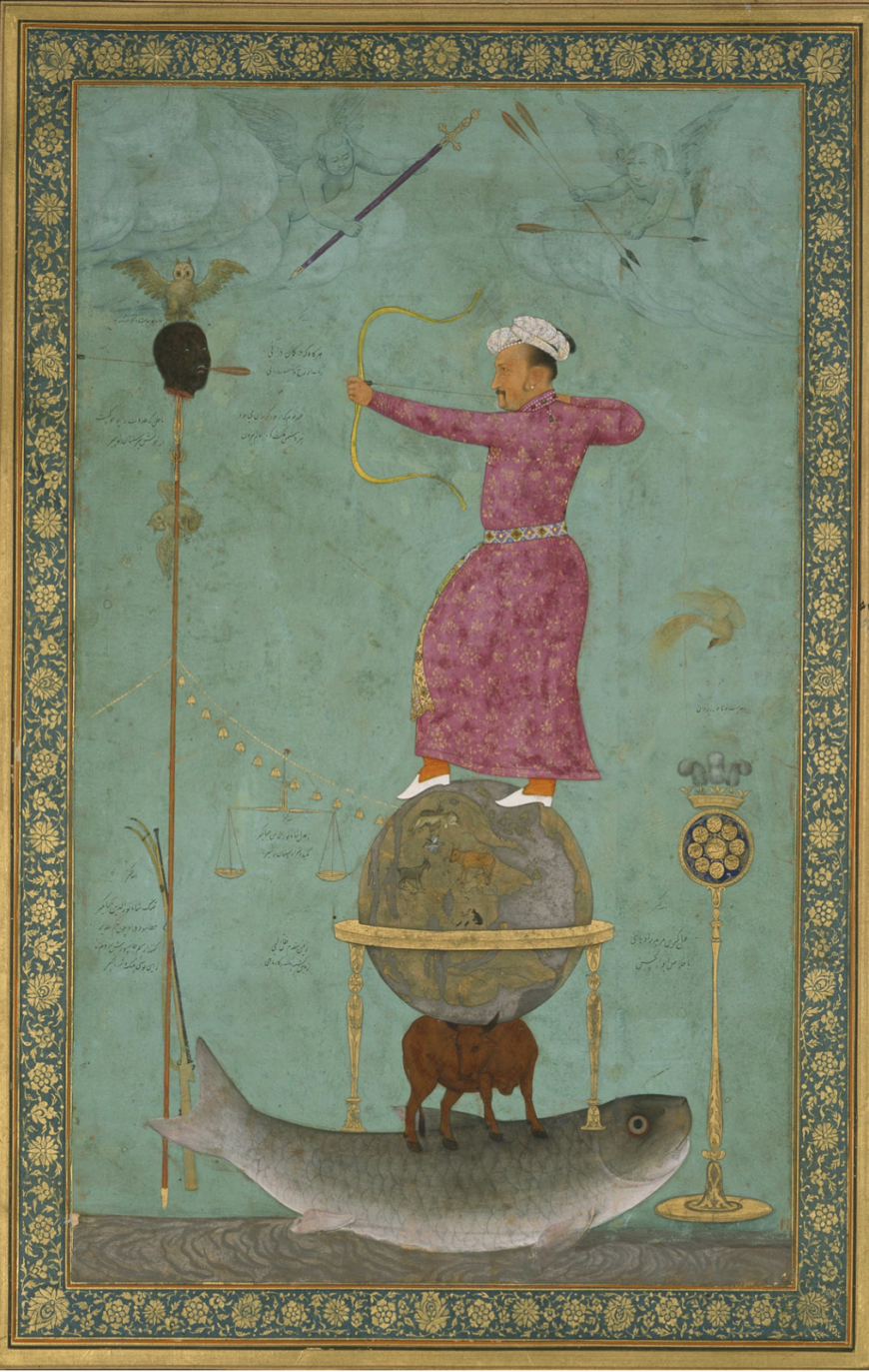
Abuʾl Hasan, Jahangir Shoots Malik Ambar, c. 1620, gouache on paper, 25.8 x 16.5 cm (Chester Beatty Library, Dublin)
Balanced on top of a globe, which in turn rests on a bull and a large fish, a regal figure shoots arrows at the severed head of a dark-skinned man impaled on a lance. Cherubs hover over him in the brilliant blue sky, offering him more weapons, while a gun rests against the lance.
The delicate lettering of Persian verses scattered within the image identifies the figures in this dramatic composition. They tell us that the archer is emperor Jahangir of the Mughal dynasty that ruled northern India from the 16th to the 18th century, and that the head belongs to Malik Ambar. Ambar was originally an enslaved African who established himself as an important military leader in India, becoming prime minister of the Ahmednagar Sultanate in the Deccan.
Challenging and resisting Mughal power in many battles, Ambar had become Jahangir’s chief nemesis in the early 1600s. In reality, Jahangir was never able to vanquish his enemy. Clearly, therefore, the painting does not present an accurate account of historical events. Rather, it is the wishful depiction of an imagined victory, and an illustration of the cosmic worldview and grandeur that its patron—Jahangir himself—wished to present.
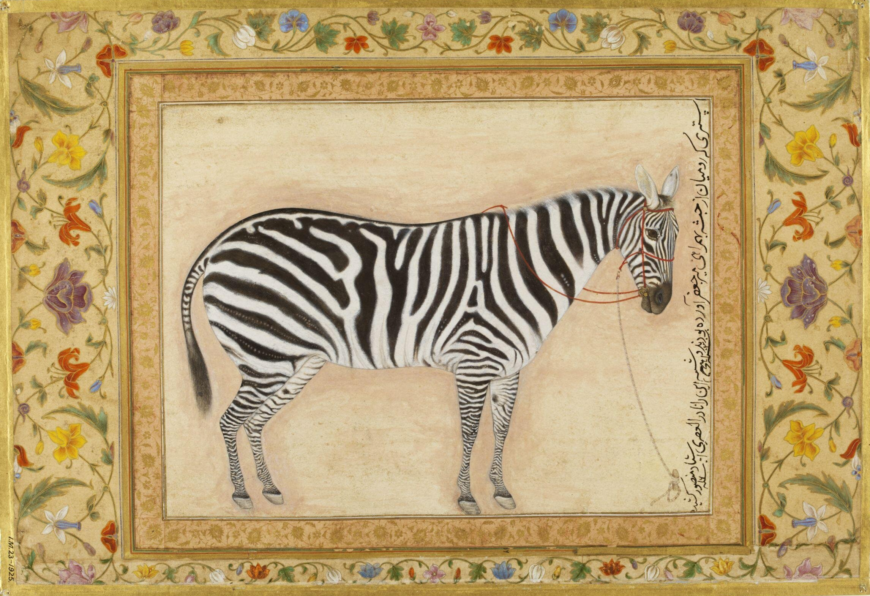
Mansur, Zebra, 1621, opaque watercolor and gold on paper, 18.3 x 24 cm (Victoria and Albert Museum, London)
Another painting from Jahangir’s workshop of artists shows a detailed, realistic rendering of a zebra. Having received the animal as a gift, Jahangir was so fascinated by its unusual form that he inspected it thoroughly. Recording his thoughts in his memoir (the Jahangirnama), he wrote: “the painter of destiny had produced a tour de force on the canvas of time with his wonder-working brush.” Ever interested in nature’s curiosities, he immediately ordered Mansur, one of his favorite painters, to depict the animal in all its glorious detail—and the result is a work that elevates precise scientific documentation to the status of sublime art.
The apogee of Mughal manuscript painting
Both these paintings, disparate as they are, represent the apogee of Mughal manuscript painting—a major tradition of miniature painting in the history of South Asia and the wider Islamic world. It emerged in the mid-16th century in the royal ateliers (workshops) of the Mughal kings (including Babur, Humayan, Akbar, and Jahangir), and remained highly influential until the late 18th century.
Known for their intricacy, luminosity, pluralism, and naturalism—in both style and subject matter—these Mughal miniatures embodied a vast range of influences and expressions. Stylistically, they synthesized influences from the Persian tradition and various regional, pre-Mughal manuscript painting traditions, as well as European Renaissance images. In terms of subject matter, these paintings served as historical documentation, visual aids for storytellers, illustrations for literary texts, recipe books, scriptures (despite the doctrinal ban against image-making in Islam), and scientific documents, and even as ritual objects.
How did a South Asian painting tradition of such range, scale, and sophistication develop under the patronage of these perennially warring, post-nomadic descendants of Central Asian conquerors?
Books and paintings: the education of a Mughal prince
Over generations, a keen interest in books, manuscripts, and paintings became integral to the education and identity of a Mughal prince. The Mughals had as their ancestors two great military figures—Turkic conqueror Timur and Mongol ruler Genghis Khan. Conquering vast swathes of land, both left behind a particular legacy of political expansionism as well as cultural refinement.
Timur’s sons and grandsons were not only great conquerors but also scholars and great connoisseurs of art. Babur, the founder of the Mughal dynasty (and an ancestor of Jahangir), was in the midst of war nearly throughout his life. Yet he managed to write the Diwan-i-Babur—a collection of poems, and the Baburnama—a memoir; as well as practice calligraphy and invent his own script (known as the Khatt-i-Baburi), commission gardens and mosques, and collect fine books and manuscripts. The love of fine books, in particular, was shared by Babur’s son Humayan, who even carried books to encampments and battles, where an entire tent would be dedicated to his library. On a visit to the Persian court of Shah Tahmasp in Safavid Persia (present-day Iran), he was struck by the aesthetic sophistication he encountered there and brought back to India two Persian master artists—Mir Sayyid Ali and Abd us Samad—who would go on to establish his imperial painting atelier.
Expansion and excellence: the atelier under Akbar
Humayun’s son and successor Akbar expanded the infrastructure for book-making and painting, and his royal atelier grew from about thirty artists in 1557 to over one hundred in the 1590s, consisting of painters, colorists, calligraphers, bookbinders, and other specialists. In order to efficiently carry out a large number of projects—including illustrated manuscripts, individual paintings, and designs for other objects—the hierarchy within the atelier remained somewhat fluid and highly collaborative. Within a given folio, a master painter composed the image based on the text to be colored in by a junior artist. The expanding atelier hired artists from far and wide: aside from local and Persian painters, artists were brought in from western India, Kashmir, and Lahore, as well as other parts of South Asia. These artists brought their own artistic traditions with them, which would not only shape the visual language that was to develop in the Mughal painting studio, but are also evident in the diversity of style within the early manuscripts.
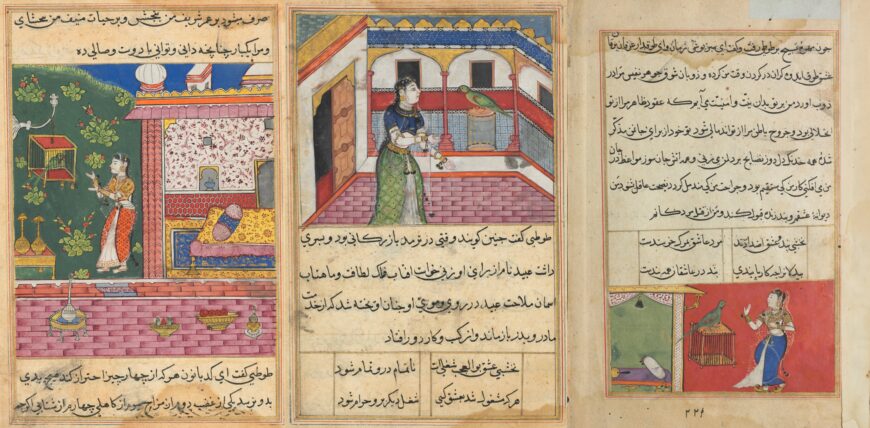
Left: The Parrot Addresses Khujasta at the Beginning of the Thirtieth Night; center: The Parrot Addresses Khujasta at the Beginning of the Forty-second Night; and right: The Parrot Addresses Khujasta at the Beginning of the Forty-seventh Night. Pages from Tutinama, c. 1560, Mughal India, court of Akbar, gum tempera, ink and gold on paper (The Cleveland Museum of Art)
The Tutinama (Tales of a Parrot), one of the earliest illustrated manuscripts commissioned by Akbar, narrates stories told by Maymun’s pet parrot to his wife Khujasta during the fifty-two nights he is away. In every illustration of Khujasta and the parrot, the influence of a different style, idiom, and painting tradition can be seen—from the shape of the parrot’s cage, placement of figures, color palette, embellishment of textiles and other ornamental details, to the elegance of style and painterly ability. The disparate styles of the atelier’s artists had not yet melded into a distinctive “Mughal” style of miniature painting.
It was the Hamzanama (“Book of Hamza,” a fictional biography of the prophet Mohammed’s uncle Hamza), made under Akbar’s reign, that became the laboratory where the Mughal style was negotiated. The project is remarkable for its sheer scale. The Hamzanama consisted of 1,400 large paintings, each approximately 69 x 54 cm, which would have been held up as story-telling aids in a popular performance tradition.
Through the successive folios of the Hamzanama, it is possible to track the arc of the developing Mughal style: combining aspects not only of Persian and Indian artistic traditions but also of Renaissance art in Europe, which caused great excitement with its striking arrival in the atelier. Renaissance images, especially Biblical ones, arrived at the Mughal courts as prints with visiting merchants and missionaries. These quickly became valuable assets for Mughal artists, who not only copied their style and subjects, but also interpreted them anew and applied this learning to everything that they worked on in the Mughal context.
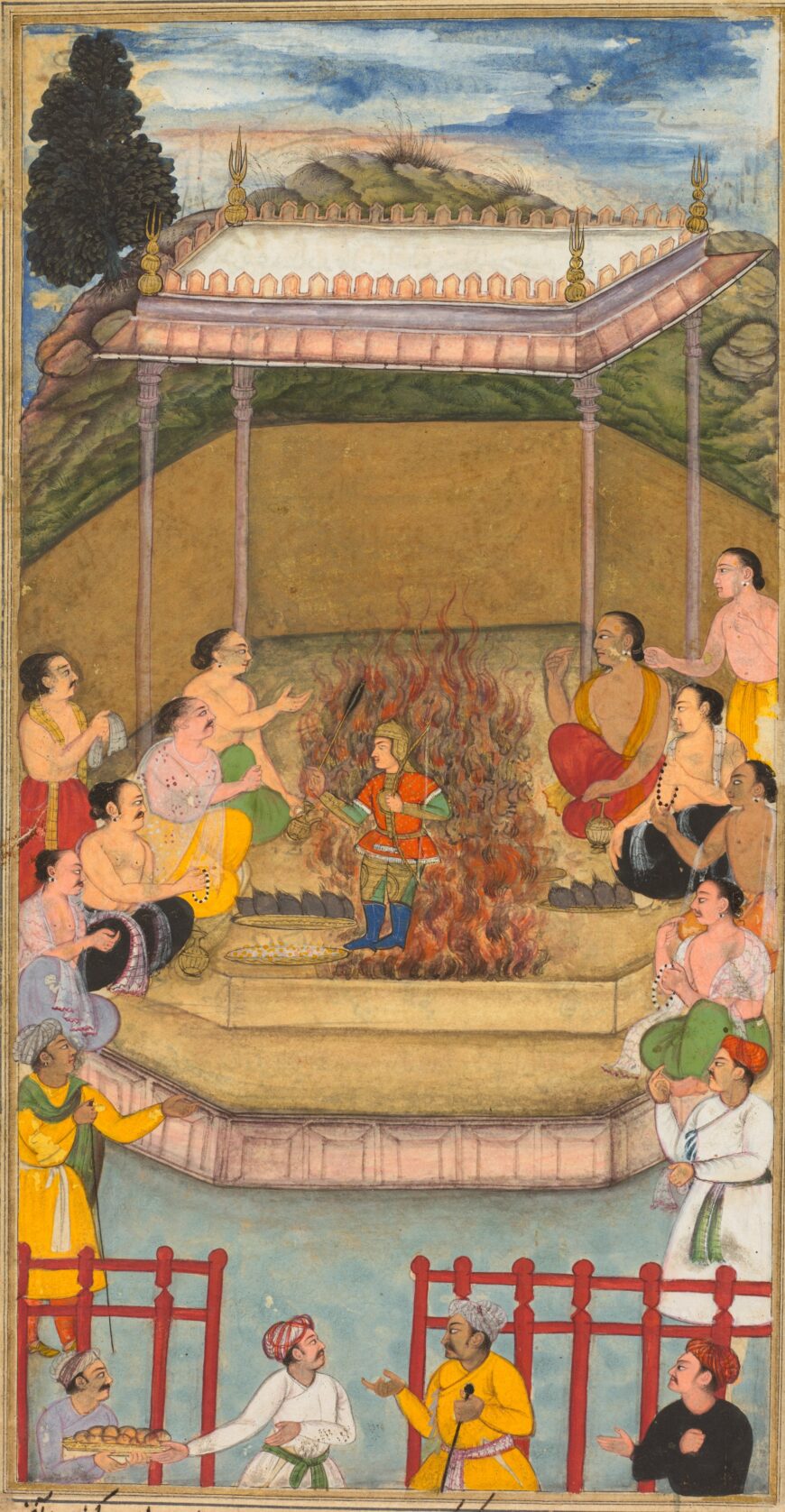
Attributed to Bilal Habshi, Yaja and Upayaja Perform a Sacrifice for the Emergence of Dhrishtadyumna from the Fire, from Adi-parva (volume one) of the Razmnama, 1598, opaque watercolor with gold on paper, 29.8 x 16.8 cm (The Cleveland Museum of Art)
The influence of Renaissance art and Christian allegorical imagery can be seen even in manuscripts that deal with Hindu themes and texts (especially the great Sanskrit epics, the Ramayana and the Mahabharata). Akbar set up a translation bureau—or maktab khana—in 1574, to translate the major Indian texts from Sanskrit into Persian. An abridged translation of the Mahabharata was prioritized as it was seen as the most comprehensive epic of Indian culture, offering a relatively secular reading for both Hindus and Muslims.
This illustrated version of the Mahabharata came to be known as the Razmnama, or Book of War. Akbar ordered all his noblemen to read and commission personal copies of these translations so that they might understand people of a different culture and build bridges between the diverse communities of India (the characters are predominantly Hindu and represent all walks of life. The stories offer an insight into the complex socio-cultural and socio-political relations between different classes and castes). These were difficult projects. Given that these were the first illustrated manuscripts of the Sanskrit epics, the Mughal artists had no visual precedents to guide them, which made the illustration of these books all the more exciting and important.
Other important illustrated manuscripts that were commissioned under Akbar’s reign include the Akbarnama (Book of Akbar), a real-time documentation of Akbar’s reign with collaboratively produced illustrations.
The story of Mughal painting in South Asia, however, had only just begun. The next major impetus came under the reign of Jahangir, the son and successor of Akbar, bringing significant changes at every level: from the composition of the imperial atelier to the style, subject matter and use of the painted image in the Mughal world.
Observation and allegory: Jahangir’s celestial vision
During Jahangir’s reign, the focus moved away from manuscripts to muraqqas (albums) and the emphasis shifted from quantity to quality. The number of artists retained by the imperial atelier for long-term projects was significantly reduced: scholars suggest that there were only about thirty artists in Jahangir’s atelier—each one a master, who worked individually on paintings. The idea of the artist as an author, an individual whose work is distinct from that of another artist, became important in this period.
Two major developments concerning subjects and style took place under Jahangir’s patronage. First, the emperor’s deep interest in the natural world led him to have his best artists produce works with animals and plants as their subject matter. As we see in Zebra, these works were naturalistic depictions of scientific precision. Second, particular emphasis was placed on realistic, accurate portraiture. This came from a deep-rooted belief in physiognomy, or the science of firasa, which regarded outward facial features and expressions as indicative of a person’s inner qualities and character.
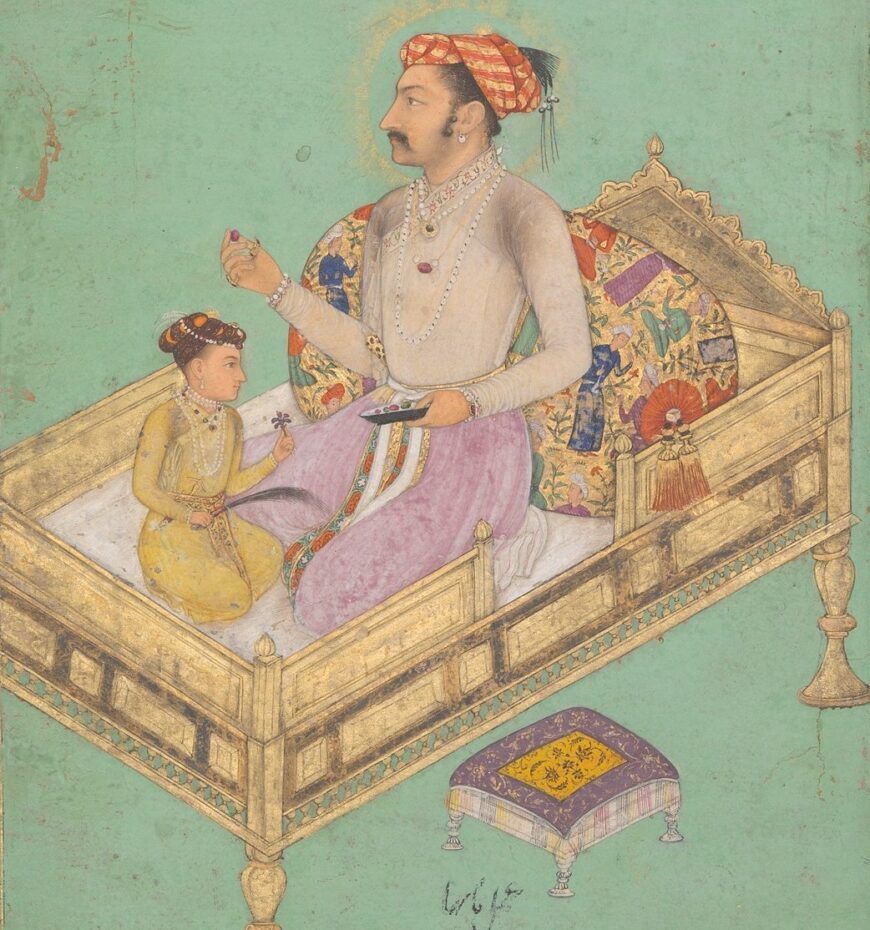
Shah Jahan inspecting jewels with his son (detail). Attributed to Nanha, The Emperor Shah Jahan with his Son Dara Shikoh, c. 1620, ink, opaque watercolor and gold on paper, margins: gold and opaque watercolor on dyed paper, 38.9 x 26.2 cm (The Metropolitan Museum of Art, New York)
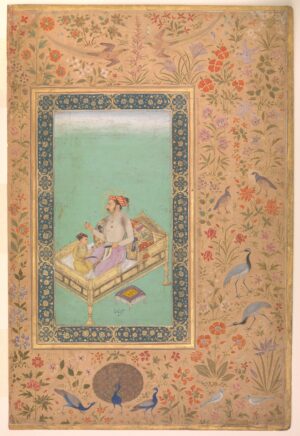
Attributed to Nanha, The Emperor Shah Jahan with his Son Dara Shikoh, c. 1620, ink, opaque watercolor and gold on paper, margins: gold and opaque watercolor on dyed paper, 38.9 x 26.2 cm (The Metropolitan Museum of Art, New York)
Jahangir had portraits painted—in profile or three-quarter profile—of himself, his sons, courtiers, and even of his enemies so that he might have a better understanding of their psychology. Nanha’s painting of Shah Jahan inspecting jewels with his young son demonstrates both of these concerns. In the central image, father and son are depicted in their royal pastime, with the future emperor Shah Jahan meditating on the qualities of a ruby, as the young Dara Shikoh holds a turban ornament. The emphasis on the likeness of facial features, the attempt to accurately capture the volume of the bodies, and the inventive use of chiaroscuro comprise a representational realism that was unprecedented in both Iranian and earlier South Asian works. The duo is framed by a wide border exquisitely illuminated with figures of birds, including peacocks, chukar partridges, and demoiselle cranes, among a variety of flowering plants—all painted in spectacular naturalistic detail.
Jahangir was interested in works that combined such close observation with layers of subtle and sophisticated symbolism. His allegorical portraits or “dream” paintings are the best examples of this combination of the real with the fantastical and metaphorical in a seamless continuum.

Abuʾl Hasan, Jahangir Shoots Malik Ambar, c. 1620, gouache on paper, 25.8 x 16.5 cm (Chester Beatty Library, Dublin)
Jahangir Shoots Malik Ambar, for example, combines the fantasized killing of the Deccan chieftain with the allusion to an actual event mentioned in Jahangir’s memoir, the Jahangirnama. A memoir entry from 1617 narrates that on the evening before Jahangir’s son (Prince Khurram) was to face Malik Ambar’s army in battle, an owl perched itself on the palace roof around dusk. As the bird was commonly considered to be a harbinger of death, the emperor felt impelled to take immediate action. A marksman par excellence, he shot and killed the bird himself with his musket just as darkness was setting in. The painting depicts this fallen owl dangling above the gun that brought it down. To its right, a pair of perfectly balanced scales hangs on Jahangir’s famous “chain of justice,” shown running between the globe and the lance, signifying the emperor’s professed aspiration for fairness. But these are the painting’s only anchors to material reality—the other motifs, while meticulously rendered, are symbols from another, more spiritual, reality. Here, the emperor embodies an all-powerful, almost supernatural being. Illustrating Islamic cosmology, the world upon which he stands rests on the cosmic bull Kujata, who in turn is carried by the giant fish Bahamut. The mythical huma bird looks after his legacy, and angels assist him in redirecting the curse of the inauspicious owl towards his enemy. A living owl is pictured atop the head of Malik Ambar as a talismanic curse.

Attributed to Bhola, Shah Jahan Honoring Prince Aurangzeb at his Wedding, c. 1640–50, painting in opaque watercolor including metallic paints, 33.7 x 23.5 cm (Royal Collection Trust)
Decline and legacy of the Mughal atelier
The atelier and its artists that flourished under the patronage of Akbar and Jahangir were only modestly functional in comparison during the reigns of Jahangir’s successors, Shah Jahan and Aurangzeb. While Shah Jahan maintained and funded the atelier, his interest and resources were mainly directed towards architecture. The paintings of this period became primarily a medium of courtly representation with a stiff formality, lacking the experimentation and aesthetic flair they showed under the previous emperors. Nonetheless, the muraqqas and illustrations from this period were highly naturalistic and technically accomplished.
Aurangzeb’s religious orthodoxy led him to move funding away from the atelier a few years into his reign, but for most of the 1660s the emperor tolerated painting as a courtly art. Several highly valued examples of portraits and court scenes in the Mughal style were produced in this period.
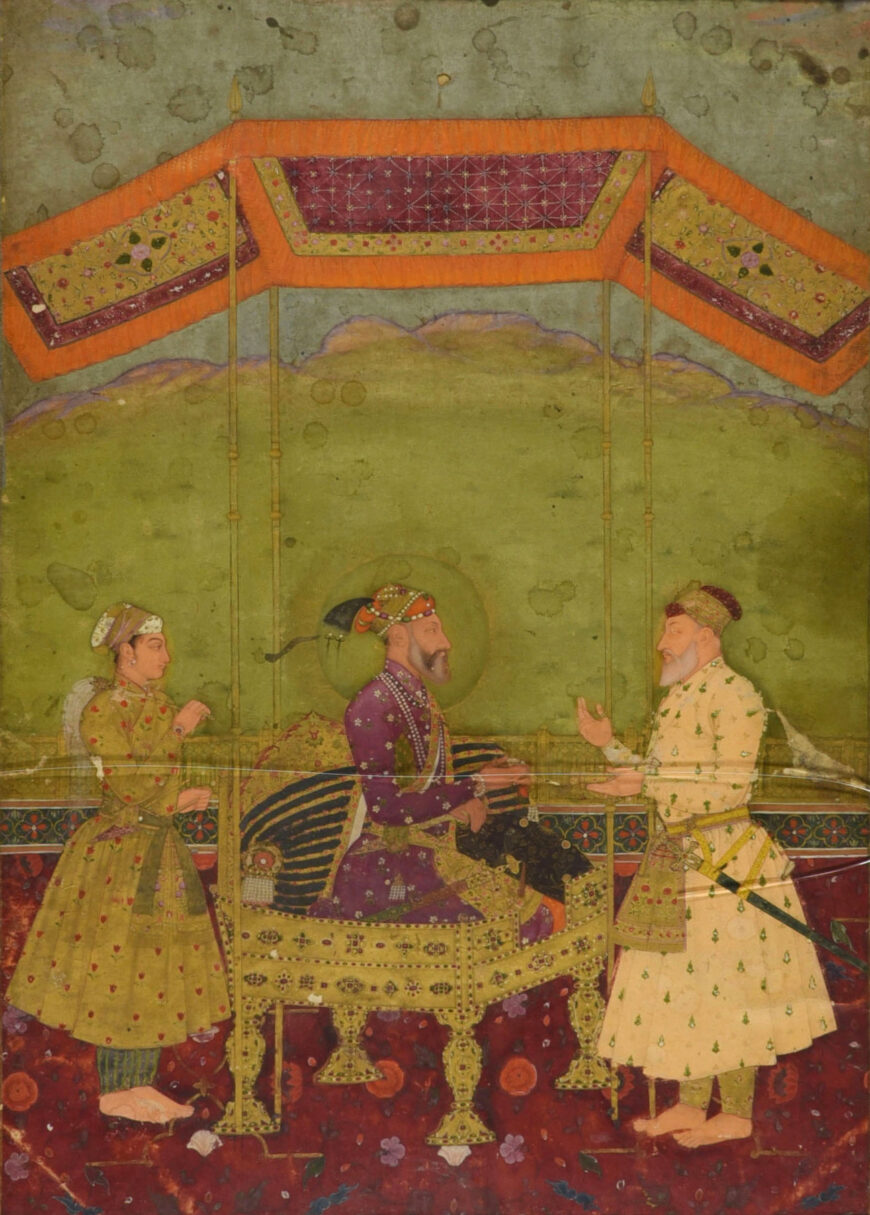
Alamgir I (Aurangzeb) Receives his Wazir, c. 1675–1700, opaque watercolor and gold paint, 30.7 x 22.7 cm (Royal Collection Trust)
With the exception of a revival under the reign of Muhammad Shah, Mughal patronage for miniature painting dwindled significantly in the 18th century. Artists were forced to seek employment outside the imperial court, which resulted in Mughal characteristics prominently making their way into the painting traditions of other regional kingdoms, particularly those of the Rajput and Maratha courts. These included the careful use of light and shadow to add volume to the figures, the naturalistic depiction of folds in clothing, and the realistic rendering of faces. Under British rule in the Indian subcontinent, the tradition of Mughal miniature painting, with its emphasis on naturalism, was incorporated into the Company School.
Today, dispersed folios and more rarely whole manuscripts in the Mughal style are housed at various museums as well as private collections across the world. Whether beheld in parts or as a whole, Mughal miniatures continue to captivate viewers centuries after their subjects, authors and patrons have passed away. This is thanks to their singular visual language, which combined intellectual erudition with extraordinary levels of artistic sophistication to create objects of everlasting beauty.
Drawing from articles on The MAP Academy


